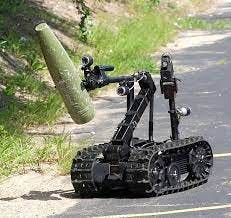Navy asks QinetiQ to build unmanned ground vehicles as bomb-disposal robots to detect and neutralize IEDs
INDIAN HEAD, Md. – U.S. Navy bomb-disposal experts are ordering additional unmanned ground vehicle (UGV) robots that are designed to detect, pinpoint, and neutralize improvised explosive devices (IEDs) and other roadside bomb threats.
Officials of the Naval Surface Warfare Center Indian Head Explosive Ordnance Disposal Technology Division in Indian Head, Md., announced an $11 million order to QinetiQ North America in Waltham, Mass., last week for option year three of production, engineering support, and post production support of the MK 2 Man Transportable Robotic System (MTRS) and Talon systems.
The MK2 MTRS robots from QinetiQ are one of several MTRS designs that provides stand-off capability to detect, identify, and dispose of IEDs and related hazards using unmanned ground vehicles equipped with special IED-disposal payloads.
The order includes production of systems, depot level repair parts, initial spares kits, consumables, repair parts, and approved accessories.
The MTRS provides the ability to locate, identify, and clear land mines, unexploded ordnance, and IEDs in the path of maneuvering Army or Joint forces.
The QinetiQ version of the MTRS is based on the company's Talon tracked unmanned ground vehicle. These lightweight vehicles are designed for IED and explosive ordnance disposal, reconnaissance, communications, countering chemical, biological, radiological, nuclear, and explosive (CBRNE) threats, security, heavy lift, defense, and rescue missions.
Talons can move as fast as six miles per hour, are transportable by one person, works in bad weather and rugged terrain, and have high payload capacity and payload-to-weight ratios.
The Talon V provides 16 I/O ports including Interoperability Profile (IOP) A and B connectors; has JAUS AS4-compliant software; supports plug and play discovery of IOP devices; offers a variety of high-definition and standard-definition camera options in addition to an optional, dual purpose Thermal/Daytime zoom camera; has a heavy-lift multiple-degree-of-freedom arm manipulator; and supports a variety of third party and legacy Talon manipulators.
On this order, QinetiQ will do the work at locations to be determined on individual task orders, and should be finished by March 2026. For more information contact QinetiQ North America online at www.qinetiq.com/en-us, or the Naval Surface Warfare Center Indian Head Explosive Ordnance Disposal Technology Division at www.navsea.navy.mil/Home/Warfare-Centers/NSWC-Indian-Head.

John Keller | Editor-in-Chief
John Keller is the Editor-in-Chief, Military & Aerospace Electronics Magazine--provides extensive coverage and analysis of enabling electronics and optoelectronic technologies in military, space and commercial aviation applications. John has been a member of the Military & Aerospace Electronics staff since 1989 and chief editor since 1995.

